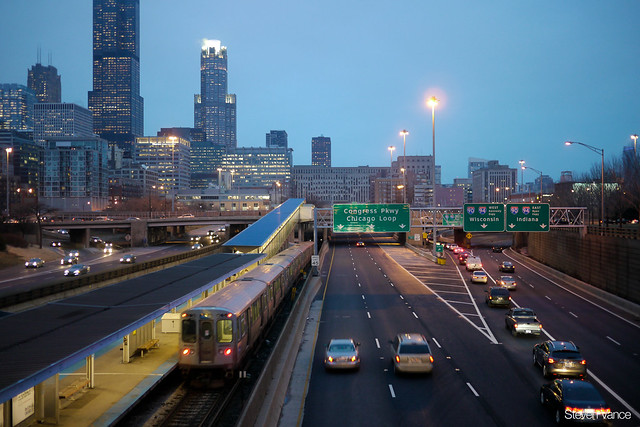The Illinois Department of Transportation's Circle Interchange highway project appeared out of nowhere. It wasn't around when the GO TO 2040 regional plan was being crafted and then adopted by 7 counties and 284 municipalities, a process that lasted from 2005 to 2010. It didn't show up until 2012, when IDOT asked the Chicago Metropolitan Agency for Planning – our region's federally-designated planning organization – to insert the project into GO TO 2040. The addition of this $400 million highway project has sparked an important discussion about what went wrong and how the regional planning process can be fixed, to prevent IDOT from ambushing it again.
On Wednesday, the CMAP board voted to insert the Circle Interchange project into the GO TO 2040 plan (three committees also voted to add the project). At the same time, Randy Blankenhorn, CMAP's executive director, acknowledged that the process was broken.
"It's a bit of a failure in the planning process and we need to fix that." he said. "How do we have a plan and two years later something of this magnitude comes basically from outside the discussion in?" Blankenhorn said that plans are not fixed in stone and can be amended, but he concluded that the addition of the Circle Interchange project had damaged the integrity of GO TO 2040, echoing a point made by others involved in the process.
In opposing the amendment, the non-profit Metropolitan Planning Council wrote [PDF]:
The [GO TO 2040] process was fair and transparent, based on the projects’ merits and reflective of CMAP’s emphasis on basing investments on accountability and transparency with a results-driven project selection process. The Circle Interchange was not among the 52 regional transportation projects that advanced to the evaluation stage during the GO TO 2040 process, which included input from IDOT.
Randy Neufeld, who sits on the CMAP bicycle and pedestrian task force, is focused on preventing the same kind of "ticking time bomb" from being dropped again. "The state [IDOT] puts out a 5-year plan every year," he said. "Only projects in the first [current] year are funded and the next four years are based on estimated revenues. The plan adds and drops projects so it's not long-range like GO TO 2040."
Neufeld wants to prevent the kind of emergency voting that characterized the Circle Interchange process. "Ultimately, what I'd like to see at next month's transportation committee meeting is some way of coordinating the GO TO 2040 process with the state's process," he said. "What else is in IDOT's 5-year plan that's a 'ticking time bomb' or is a huge project we don't know about?"
Neufeld agrees with MPC that spending money on this project means not spending on another project -- one that may be needed more urgently or is better suited for the multi-modal future that Chicagoland needs to work toward. The counties and municipalities of the region weren't given a chance to decide if the Circle Interchange should be that project, even though it was in the hands of the CMAP MPO Policy Committee and Board.
Meanwhile, IDOT issued a gloating press release about the CMAP voting:
"Through a comprehensive and transparent process, we have identified a plan for the Circle Interchange that will keep our region and our economy moving," Transportation Secretary Schneider said. "We applaud CMAP's decision to support Governor Quinn's efforts to enhance safety and improve congestion at the Circle Interchange and include this project in the region's long-range plan, so we can continue our planning and design efforts without delay."
The Circle Interchange process was actually the opposite of "transparent and comprehensive" -- it was rushed, and CMAP's own executive director admitted it was flawed. The project has a fraction of the economic benefits of other projects that didn't make the cut into GO TO 2040.
We need to fix this. Chicago is trying to attract people to live here, not shuttle them over and past Greektown at 40 MPH at a time when other communities around the country are tearing down highways because they divide neighborhoods.
Our region should push for better planning coordination and a smarter balance of funding between highway, transit, walking, and biking projects. While the Circle Interchange project is going to happen, we should ensure that this obtrusive project, with its three new flyovers above Halsted and Harrison Streets, has the smallest possible impact on our neighborhoods, and our transit system.
A public hearing on the Circle Interchange project is scheduled for April 3, from 4 to 7 p.m. at the Marriott Chicago at Medical District/UIC, 625 South Ashland Ave.






